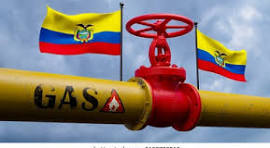Worsening Erosion Disruptions On Pipelines Slashes Ecuador Output by 133,000 bpd

Jul 05, 2025
Ecuador’s state oil company, Petroecuador, has declared force majeure on its operations after both major crude pipelines, SOTE and OCP, halted flows due to worsening erosion in the Amazonian province of Napo.

The company suspended activities this week to prevent further damage to critical infrastructure as erosion along the Coca River continues to threaten oil transport lines and the Coca Codo Sinclair hydroelectric plant, Ecuador’s largest.
The suspension has already cut Ecuador’s crude output by an estimated 133,000 barrels per day (bpd), based on Petroecuador data, placing fresh strain on the country’s oil-dependent economy. Ecuador produced about 464,000 bpd on average in 2024, according to official statistics.
“Force majeure has been declared so that (Petroecuador) can act with all the tools necessary,” Petroecuador chief executive Leonard Bruns told Reuters.
This is the latest in a series of setbacks for the company. In May, operations at the Esmeraldas refinery, the country’s largest, with a 110,000 bpd capacity, were suspended after a fire damaged a fuel oil tank.
Two months earlier, a landslide in the northeast led to one of the country’s worst oil spills in years, prompting Petroecuador to shut down the SOTE pipeline and declare a 60-day force majeure. Approximately 25,000 barrels of crude spilled into rivers near the Colombian border, disrupting crude exports.

Ecuador’s signature export, Oriente crude, is a medium-to-heavy sour grade with an API gravity of 23.6 and sulfur content of 1.61%. Last year, the SOTE system transported over 104 million barrels of Oriente crude.
Petroecuador has declared force majeure multiple times in recent years, including in 2022 when it suspended nearly half its production amid protests by the Kichwa community over alleged breaches of social and environmental agreements.
Ecuador remains one of South America’s key oil producers, alongside Venezuela and Colombia.
The oil sector remains central to the country’s economy, generating roughly $8.6 billion in revenue in 2024, equivalent to about 7% of GDP, according to the Ministry of Finance. However, output has dropped nearly 100,000 bpd over the past decade due to underinvestment, aging fields, infrastructure failures, and political volatility.

President Daniel Noboa has set a target of $42 billion in oil sector investment to reverse this decline and raise production. Last month, Petroecuador awarded a drilling contract to China’s Sinopec to develop fields in the Ecuadorian Amazon. The new drilling campaign is only expected to add approximately 12,000 bpd over the next several years, according to company estimates.
Still, Ecuador’s ambitions may be running up against global market headwinds. Oil prices have moderated significantly since their 2022 peaks during the global energy shock triggered by Russia’s invasion of Ukraine.
Brent crude averaged around $83 per barrel in the first half of 2025, down from over $100 in mid-2022. Lower prices reduce the return on investment for new upstream projects, particularly in environmentally sensitive or high-cost regions like the Amazon basin.
This price softening coincides with a broader slowdown in energy investment worldwide. Although global upstream spending remains elevated by historical standards, international oil companies have become more cautious in politically unstable markets.
For Ecuador, which requires an estimated $10 billion in upstream investment over the next five years just to offset natural decline, this poses a significant risk.
Ecuadorian officials have projected national oil production could peak at 600,000 bpd in 2026 before declining to around 395,000 bpd by 2028, a figure that appears in internal planning documents reviewed by local media. Petroecuador’s fields face particularly steep decline rates, though the oft-cited 23% annual figure has not been publicly confirmed by the company.
According to a July 3 analysis by economist Freddy García of Andersen Ecuador, the production cutback to 332,129 bpd has resulted in daily losses of around $8 million. García warned that the government would likely need to revise its budget plan and seek new external financing to close the fiscal gap.
“The loss of revenue forces a revision of the budget or the search for external financing to cover the gap,” he said.
He also noted that oil revenue is no longer a reliable base for public spending due to production volatility and declining field productivity.
Ecuador also faces broader energy security issues. Grid reliability is increasingly strained by both hydroelectric vulnerabilities and fossil fuel disruptions. Yet with a fiscal deficit exceeding $5 billion and high sovereign debt levels, the country has little room to reduce reliance on oil.






